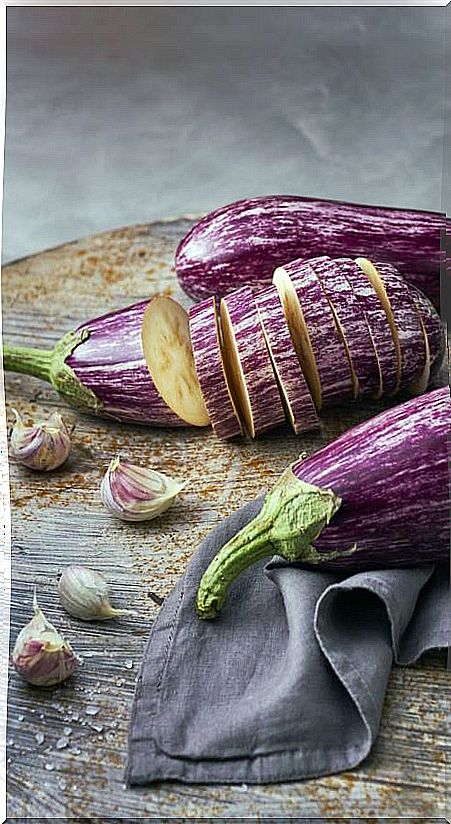How To Cook Aubergines Easily And Quickly
Let aubergines enrich your diet with these tricks so that they are always perfect for you

We can find in the market a few varieties of aubergines: purple, striped, white, long, etc. In general, with all of them we can cook the same, although the biggest difference is that long aubergines, Chinese and Japanese, tend to be less bitter.
Eggplants are very versatile in the kitchen. They are very light for their size because their interior is spongy, full of air. Choose those that are heavy for their size, that have shiny and smooth skin, without wrinkles, that are not too hard (they would be green, more acidic, a little more bland). If they are soft they are too ripe, they will have large seeds inside and the taste will be more bitter.
To preserve them well, store them in the least cold part of the refrigerator (for example, in the vegetable drawer). At less than 10ºC they can turn brown and soft quickly, just as if it is very hot (more than 22ºC), so it is best to store them for a short time, consume them as soon as possible.
4 ways to cook eggplants
The color of the skin of black and purple aubergine is due to its anthocyanin content, pigments that are sensitive to the pH of the cooking medium and to temperature. The more acidic it is, the more reddish it is. If you want to preserve the color of aubergines pink or purple, you can soak them with water, salt and a pinch of vinegar.
With cooking, especially in the oven, dehydration occurs and the skin may turn more brown. To avoid this you can make the aubergines at a lower temperature and protecting the skin with liquids (for example a broth). Anyway it is only an aesthetic question, they will be just as good.
1 stuffed aubergines
To fill aubergines it is better to use large and oval pieces, which we can cut in half lengthwise and put a good amount of our filling. We can use sautéed vegetables and vegetables, cereals (brown rice, millet, buckwheat, etc.), legumes (lentils, beans, chickpeas), or a little of everything.
For example, we can fill some aubergines with what we have left over from a lentil curry, or with textured soy stew, or with spiced roasted chickpeas and a béchamel made with vegetable milk.
As the filling is usually already done, first we will cut the aubergines lengthwise, prick them with a fork, sprinkle salt and let them rest for half an hour. Then we wash and roast in the oven at 200ºC until they are tender.
We remove them, with a spoon and a knife we remove the central meat of the eggplant (to put the filling) and we mix this meat with our filling.
Fill the aubergines and put them back in the oven until golden brown and the filling slightly gratin.
2 sauteed eggplants
For me the best way to sauté aubergines is to steam them first.
Cut them into cubes and put them in a bowl with water and salt for 30 minutes. Drain, wash very well and steam 6-7 minutes, until tender (but not undone). Then add them to the pan to sauté them. They will be very tender, juicy and golden, without absorbing too much oil.
3.Roasted aubergines
Sometimes what I do is grill a bunch of veggies at once to have for the whole week. In the case of the aubergines, I put them whole, just pricking them a little with a fork, and in the oven.
With these roasted aubergines, whose meat will be very creamy, we can make vegetable pâtés such as babaganoush, pasta sauces and accessories for any dish.
With the meat of the roasted aubergines, I also make vegetable burgers (you just have to mix it with the rest of the ingredients), toppings for pizzas, quiches, etc.
4 fried eggplants
I don’t recommend frying eggplants, they tend to absorb a lot of oil given their internal structure, which is almost all air. The best thing we can do for some fried aubergines is to first soak them with water and salt (half an hour, drain, wash) and then bread or coat them to prevent too much oil from getting inside the eggplant.
For example, when we make a vegetable tempura, we can add the aubergine by cutting it into strips or sticks, leaving it soaked with the salt and then passing it through the tempura and into the pan with the hot oil (do not add them until the oil is very hot). Then let them rest on absorbent kitchen paper.
How to reduce the bitterness of eggplants
The most bitter aubergines are purple or black, especially if they are very ripe, because they contain more phenolic acids with a bitter and strong taste. Some of these compounds are removed or neutralized with cooking, but we can remove a little more by osmosis.
Cut the aubergines into cubes, slices or in half lengthwise (depending on how you are going to prepare them), sprinkle them with salt and let them rest for 30 minutes. After that time you will see that the eggplant has “sweated”. Drain them, wash them under running water and pat them dry with kitchen paper.
The grains of salt that we have sprinkled make water and part of the bitter-tasting compounds come out of the eggplant cells, resulting in those droplets that we will see above. These drops continue to draw liquid from the interior in a slow process, so it is advisable to leave them for half an hour.
With this method we have more whole aubergines, which do not fall apart so easily. It is especially recommended if you want to make them grilled, grilled or in a stew with more ingredients.
We can also do it by leaving the pieces soaked with water and salt, an equally effective method but more recommended if what we want is for the eggplant to absorb water and be even more tender. Aubergines like this are more meaty, tender, soft and juicy, but it is also easier for them to fall apart.









